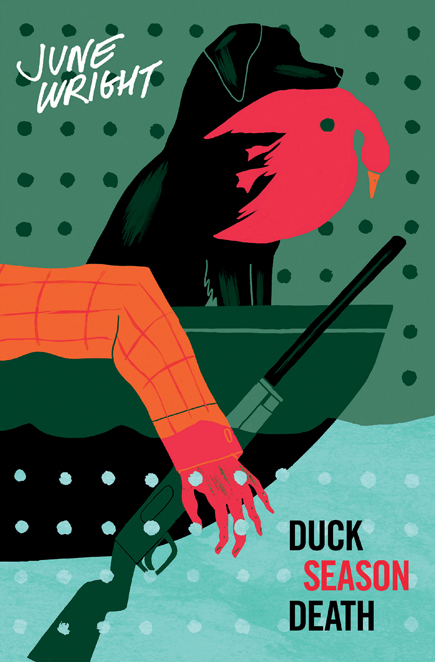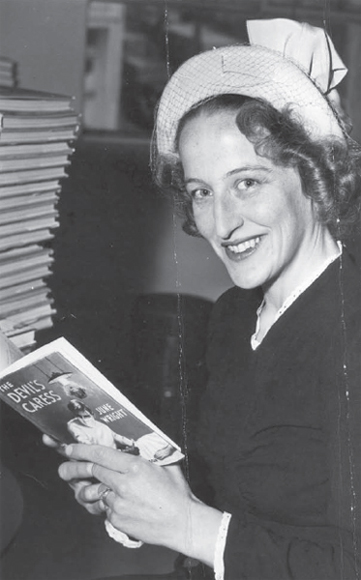Duck Season Death
Authors: June Wright


DUCK SEASON DEATH
ALSO BY JUNE WRIGHT
Murder in the Telephone Exchange
So Bad a Death
The Devil's Caress
Reservation for Murder
Faculty of Murder
Make-Up for Murder

© 2014 the Estate of Dorothy June Wright
Introduction © 2014 Derham Groves
All rights reserved. No part of this book may be reproduced, stored in or introduced into a retrieval system, or transmitted in any form or by any means (digital, electronic, mechanical, photocopying, recording or otherwise), without the prior written permission of the publisher, except by a reviewer, who may quote brief passages in a review.

A Dark Passage book
Published by Verse Chorus Press
PO Box 14806, Portland OR 97293
Cover design by Mike Reddy
Interior design and layout by Steve Connell/Transgraphic
Art on next page by Emilie Jane Wright
Dark Passage logo by Mike Reddy
Library of Congress Cataloging-in-Publication Data applied for
ISBN 978-1-891241-98-7 (ebook)


INTRODUCTION
The crime novels of Australian author June Wright (1919â2012) have been unfairly forgotten, and in my view thoroughly merit a fresh reassessment. The mother of six children had six books published by Hutchinson in London between 1948 and 1966. “June demonstrates herself to be both mentally and physically fertile,” observed the outspoken journalist Beth Thwaites in
The Truth
newspaper in Melbourne, Victoria. Interesting locations, spirited female characters and believable social settings are characteristic of all of June's murder mysteries.
After June's first child, Patrick, was born in 1942, “to combat the lack of mental exercise, I haunted the local lending library for reading matter,” June recalled in 1997. “But, owing to the war, there was not a large supply . . . I read all of the novels by Frances Parkinson Keyes and a new authoress called Monica Dickens. Dynastic epics covering generations of English family life soon dried up. Agatha Christie was a favourite; Mignon Eberhart, a skilled performer of the âHad I but known' school, more so. That's it, I thought after a period of re-reads. I'll write my own!”
Being an avid reader of crime fiction, June knew precisely how to proceed. “You must drop your clues, like stitches, on the way out, and pick them up neatly in a pattern when you're coming in,” she told the Australian magazine
Woman's Day
in 1948. “The clues give the reader a chance and you mustn't fool him with any misleading trickery. You must have a plausible plot and the murderer must get an honourable mention early in the book, although you
never let the reader into his mental processes. There must be no coincidences or unaccountable solutions.”
June had to juggle writing with looking after her husband, Stewart, and their six children: Patrick, Rosemary, Nicholas, Anthony, Brenda and Stephen. Six nights a week (her one night “off” was spent ironing clothes!), after the children had gone to bed, she escaped to her study to write for two or three hours, come what may, when “the dozens of ideas she has while peeling potatoes and washing nappies spill from her brain into print,” wrote Lisa Allan of
The Argus
newspaper in Melbourne. “And therein are the two essential ingredients for writing [June] saysâpatience and perseverance. âIt's easy to dash off 200 inspired words, but the other 80,000 to finish the book aren't always so quick in coming.'” Writing about 1,000 words in longhand per night, the first draft of a book usually took June three or four months to complete, “unless something cataclysmic happens to the family in the meantime,” she told the author of “Housewife's Recipe for Murder” (1958).
June's first crime novel,
Murder in the Telephone Exchange
(1948), was set in the Central Telephone Exchange in Melbourne, where she had worked as a telephonist during World War II. In this book Sarah Compton, a supervisor, is bashed to death with a “buttinsky,” a gadget used by telephone mechanics to interrupt telephone conversations. Maggie Byrnes, a gutsy young telephonist at the exchange (like June was), narrates the fast-moving whodunit, which outsold Agatha Christie's novels in Australia in 1948. (Verse Chorus Press reissued
Murder in the Telephone Exchange
in 2014.)
Most book reviewers were full of praise for June's maiden effort. However, she was completely floored by the following slap on the knuckles from A.R. McElwain, the influential crime fiction reviewer for two widely read daily newspapers,
The Advertiser
in Adelaide, South Australia, and
The Herald
in Melbourne, whom June later described as “a devotee of the detective story and a zealous guardian of its mores.” “Above all, Miss [sic] Wright must never again aggravate the honest student's blood-pressure by resorting to a low, inexcusable trick to lead him off on the wrong trackâright there on page one at that,” wrote McElwain in his review of
Murder in the Telephone Exchange
. This led to a friendly exchange of letters between the author and the reviewer. McElwain encouraged June to read
The Art of the Mystery Story
(1946) edited by Howard Haycraft. “It is the best anthology of practically everything good that has been written about detection stories and contains criticism and hints by all of the dons of the craft,” he said. June henceforth regarded McElwain as her literary guide.


JUNE WRIGHT IN 1952
So Bad a Death
(1949), June's second murder mystery, also features Maggie Byrnes, who is now married to John Matheson, a police inspector whom she met during the investigation of Sarah Compton's murder. In this book the newlyweds rent “Dower House” in Middleburn, a fictitious Melbourne suburb, which was based on Ashburton, the real Melbourne suburb where June lived at the time. Despite Middleburn's outward gentility, it proves to be a hotbed of crime.
So Bad a Death
was serialised on ABC radio and also in
Woman's Day.
June's third book,
The Devil's Caress
(1952), is more of a psychological thriller than a whodunit. It features Marsh Mowbray, an attractive young GP, who is unwittingly pitted against her boss, Katherine Waring, a Senior Honorary Physician at the hospital where she works, and Katherine's husband Kingsley, a leading Melbourne surgeon, while staying at the Warings' beach house at Matthews, a fictitious hamlet on the Mornington Peninsula in Victoria. “Mrs. Wright's reportage is as ever brisk and competent,” commended A.R. McElwain in his review of
The Devil's Caress.
“But I eagerly await the day when she concentrates more upon genuine, plausible detection and less upon melodramatic situations.”